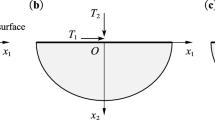Abstract
A new model for determining elastic/plastic indentation is presented. This model generalizes Johnson's incompressible core model to a compressible material and allows the indentation pressure to be transmitted via a misfitted inclusion core beneath the indenter which is surrounded by a hemispherical plastic zone. The internal stress field inside the core is obtained by applying Eshelby's spherical inclusion problem together with Hill's spherical-cavity expansion analysis. The plastic deformation considered here exactly ensures compatibility between the volume of a material displaced by the indenter and that accommodated by expansion. The analysis explains the essential relationships between the dimensions of the indentation and plastic zone and the dominant material properties; yield stress, hardness and elastic modulus. The solution is extended to evaluate the indentation fracture toughness by taking into account the reduced half-space constraint by the image force.
Similar content being viewed by others
References
B. R. Lawn andT. R. Wilshaw,J. Mater. Sci. 10 (1975) 1049.
B. R. Lawn, A. G. Evans andP. B. Marshall,J. Amer. Ceram. Soc. 63 (1980) 574.
G. R. Antis, P. Chantikul, B. R. Lawn andD. B. Marshall,ibid. 64 (1981) 533.
S. S. Chiang, D. B. Marshall andA. G. Evans,J. Appl. Phys. 53 (1982) 298.
Idem, ibid. 53 (1982), 312.
K. Tanaka, Y. Kitahara, Y. Ichinose andT. Iimura,Acta Metall. 32 (1984) 1719.
K. Tanaka,Nihon Kinzoku Gakkaishi 48 (1984) 1157 (in Japanese).
R. Hill, “The Mathematical Theory of Plasticity” (Oxford University Press, London, 1950).
K. Johnson,J. Mech. Phys. Solids 18 (1970) 115.
J. D. Eshelby,Proc. Roy. Soc. A241 (1957), 376.
Idem, ibid. A252 (1959), 561.
K. Tanaka,Scripta Metall. 19 (1985) 1183.
R. D. Mindlin,Physics 7 (1936) 85.
S. Timoshenko andJ. N. Goodier, “Theory of Elasticity” (McGraw-Hill, New York, 1951).
D. M. Marsh,Proc. Roy. Soc. A279 (1964) 420.
W. Hirst andM. G. J. W. Howse,ibid. A211 (1969) 492.
S. Nishijima,Trans. NRIM 19 (1977) 327.
Idem, ibid. 20 (1978) 314.
NRIM Fatigue Data Sheet, National Research Institute for Metals, Tokyo, Japan, no. 1–4, (1978), no. 8–10 (1979).
S. Muneki, Y. Kawabe, K. Nakazawa andH. Yaji,Tetsu-to-Hagane 64 (1978) 605 (in Japanese).
W. H. Sutton,Astronautics and Aeronautics (AIAA) August (1966) 46.
A. Kelly “Strong Solids” (Oxford University Press, 1966).
C. M. Perrott,Wear 45 (1977) 293.
T. O. Mulhearn J. Mech. Phys. Solids 7 (1959) 85.
S. Van Der Zwaag, J. T. Raga andJ. E. Field,J. Mater. Sci. 15 (1980) 2965.
J. T. Hagan,ibid. 14 (1979) 2975.
N. H. Burlingame, M S Thesis, University of California, Berkley, (1980).
J. T. Hagan,J. Mater. Sci. 14 (1979) 462.
Idem, ibid. 15 (1980) 1417.
K. Tanaka, unpublished work, 1985.
M. H. Lewis, R. Fung andD. M. R. Taplin,J. Mater. Sci. 16 (1981) 3437.
E. L. Exner, J. R. Pickens andJ. Gurland,Met. Trans. 9A (1978) 736.
Author information
Authors and Affiliations
Rights and permissions
About this article
Cite this article
Tanaka, K. Elastic/plastic indentation hardness and indentation fracture toughness: The inclusion core model. J Mater Sci 22, 1501–1508 (1987). https://doi.org/10.1007/BF01233154
Received:
Accepted:
Issue Date:
DOI: https://doi.org/10.1007/BF01233154




